In honor of World Penguin Day, we’re sharing an amazing story that’s incredibly close to our hearts. It’s a story about one of our feathered friends who is on the road to recovery from a medical defect to her spinal cord. A year ago, Victoria the penguin couldn’t walk. Now, thanks to the care, attention and love of Newport Aquarium’s dedicated biologists, she’s making great progress.
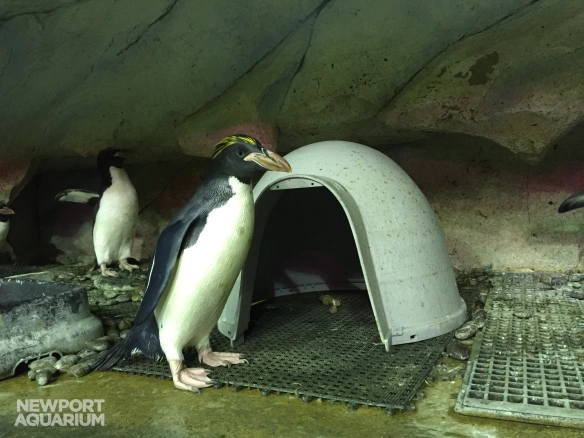
Victoria and Clifford in the penguin loft – November, 2016.
Victoria the Macaroni penguin came to Newport Aquarium in 2010, with her mate, Clifford. “She’s a real sweetheart – a super friendly bird,” said Dan Clady, Senior Biologist. Before her injury, guests could often find the pair spending time together in the loft area in the Penguin Palooza habitat.
Vet Visit
Senior biologist, Dan Clady, first noticed something was wrong with Victoria in February 2017, when she was seen laying around in Penguin Palooza, and not walking. Clady was baffled; he had been working with penguins since 1999 and had never seen anything like it. Initially, Clady thought Victoria had somehow broken her back when he found her in Penguin Palooza.

Penguin Palooza is home to nearly 50 penguins.
But the bird’s condition was a mystery as “There was no possible way that she fell, causing a traumatic event that way,” said Jolene Hanna, Animal Health & Quarantine Manager, and Veterinary Technician.
Close to 50 penguins live in Penguin Palooza, including King penguins, Macaroni, Southern Rockhopper, Gentoo and Chinstrap penguins. Clady and Hanna turned to Newport Aquarium’s Director of Veterinary Services, Dr. Peter Hill, who took X-rays, which showed no broken bones. “She could not bring herself into an upright position,” said Hanna. “We could not find through the radiograph why this bird was not able to stand.” Dr. Hill started Victoria on a round of medicine, including anti-inflammatories, pain reducers and steroids as part of her treatment.
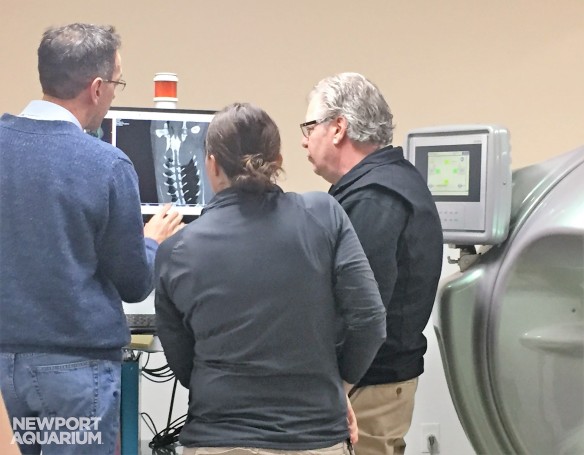
Dr. Joseph Bruner (left), Jolene Hanna, and Dr. Peter Hill review Victoria’s X-ray at Greater Cincinnati Veterinary Specialists. The X-ray showed no broken bones.
“Because blood clotting was a possibility, we had to rule that out. So we put her on a series of drugs to try to figure out what we could rule out in terms of what could be the problem,” Hanna said.
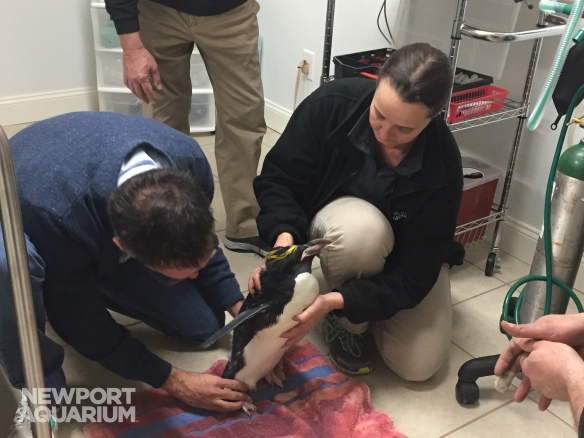
Victoria could not stand on her own.
After about a month, nothing changed. That’s when they decided to take Victoria in for a CT scan, which revealed a hole in her spinal cord. “It’s a defect and it was in the center of the spinal cord right at her pelvic girdle,” said Hanna, “it impacted her nerves.”

A CT scan revealed a pin-sized hole in Victoria’s spinal cord.
Dr. Hill says he’s happy they were able to identify the lesion. “Often times these things go undiagnosed due to lack of equipment, and not testing for it.”
Swimming in Circles
Clady says the best physical therapy for Victoria was to get her back in the water, and Dr. Hill agrees. Another big step towards recovery has been to make sure she’s spending time with her fellow penguins.
“These are colonial birds, they don’t like being alone,” Clady said. Victoria gets physical therapy every day, and you can find her swimming in Penguin Palooza from 8:30-2:30 daily for her water therapy. Victoria is easily identified thanks to a red tag on both of her wings. She’s the one swimming in circles in the exhibit, as she makes progress on her left foot. She now has full control of her right foot.
“It’s a testament to the staff that we pursued this, and stuck with the physical therapy, and saw this treatment through, to where we are today,” said Dr. Hill.
Molting
Victoria couldn’t spend all her time in Penguin Palooza, especially when she started molting. All birds molt – they lose their feathers. Penguins have a unique molting process.

Penguins have a unique molting process. They shed all of their feathers at once.
“When they molt, they get hot, like physically hot,” said Clady. That’s a natural condition normal in their native cold environment. Victoria went through her molt in early March, which is different than most birds because while other birds only shed a few feathers at a time, penguins shed all of their feathers at once. During Victoria’s molting season, Clady moved her into the “cold room” behind the scenes, for a different form of therapy.
Snow Spa
Victoria started receiving a “snow spa” treatment. She spent her days lying in fresh snow that Dan shoveled daily just for her, until she finished molting. Dan described the process of molting as uncomfortable for Victoria, comparing it to a baby teething.
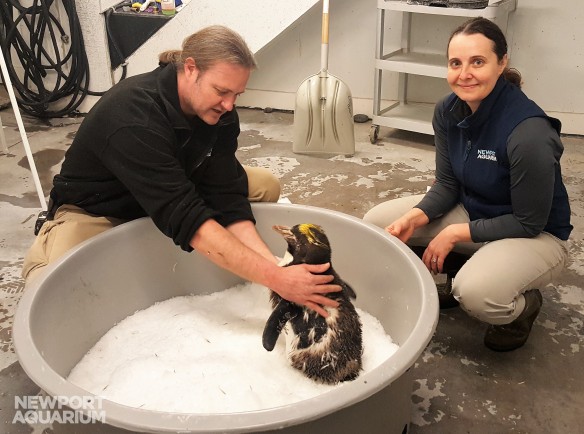
Introducing Victoria to her “snow spa” behind the scenes. It helped her stay cool during her molting process.
Penguins have a core temperature of 101 degrees and can easily overheat. The “snow spa” that Dan set up for her helped her stay cool and comfortable while she was going through molting. Molting is a normal process but with her working on recovery from her spinal condition, the animal care team was happy to do anything they could to make her more comfortable.
“She sat in that snow, and started digging around. She enjoyed being able to cool off in there,” Clady said. “It alleviated the pressure on her chest too.”
Making Progress
A year later, Victoria has full control of her right foot, she’s still working on her left foot.
She’s now able to prop herself up, and Dan helps her stabilize herself. “She keeps taking a step in the right direction, and she’s constantly getting better.” said Clady.
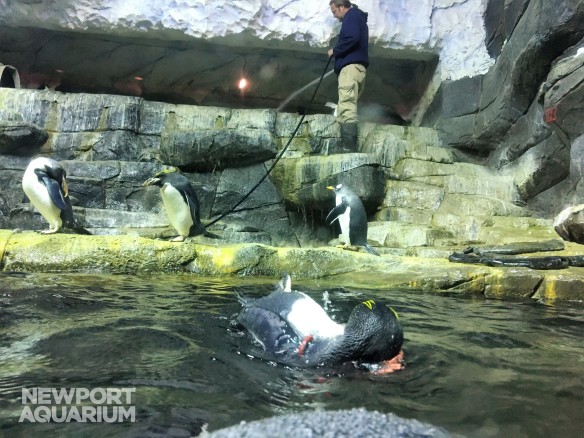
Victoria floats around on top the water, while Senior Biologist, Dan Clady, sprays the rockwork in Penguin Palooza.
Victoria is improving over time, and Dr. Hill says spinal cord lesions take a lot of time to improve. It’s thanks to the attentiveness of her dedicated animal care team that Victoria has made the progress she has so far.
“The upside is she is able to swim, and that’s ideal for her mental attitude and physical therapy. She’s maintained a sense of mental balance. Without that, I think she would’ve deteriorated. Without a stimulus, physical therapy and the enrichment of being around birds, she would’ve likely deteriorated quickly – from not only a mental state, but also muscle atrophy,” said Dr. Hill.
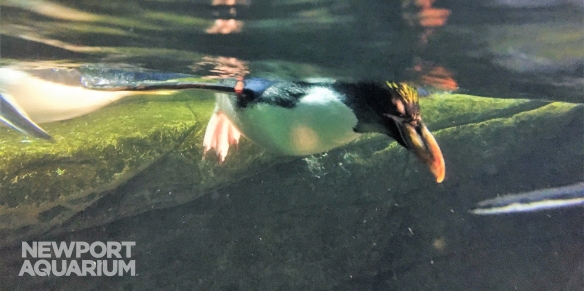
Victoria takes a dip underwater. She’s easily identifiable by her red wing bands.
The animal care team continues to work with Victoria as she heals and improves. You might think Victoria’s the one getting all the benefit from this care. But it’s clear in talking with each of the Newport Aquarium animal experts, from Dan to Jolene to Dr. Hill and many others, they are each nurtured by their special relationship with Victoria.
















